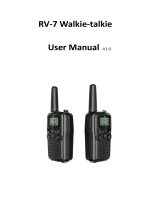
13
CTCSS- or DCS CODE SCAN (*)
Setting the CTCSS or DCS code to 00, allows all signals to be heard
but is not possible to transmit. Using the CTCSS or DCS scan, all
codes from whatever channel can be scanned and as soon as you
receive a signal, talking back is possible if using the same CTCSS or
DCS code. Your walkie-talkie stays tuned on that particular channel.
Press 6 x the MENU button to start the CTCSS
scan or
Press 7x the MENU button to start the
DCS-scan
“SG” icon will flash as well as “CTCSS” or
“DCS”
Press or oto start the channel scan
( = scan channel up, = scan channel
down)
The FR-66 will scan all channels and stops if
an incoming transmission is detected.
After more than a second when the signal has
stopped, scanning will be continued
Press the PTT button to talk back. To
successfully communicate using a privacy
code, both the sending and receiving radios
must be tuned to the same channel and to the
same privacy code system (CTCSS or DCS)
and privacy code number, last received. If
talking back the scan will stop
Note: All channels that are set to CTCSS or DCS code 00 will be
skipped during this scan method
*: CTCSS and DCS code will be are further explained on page 18
6x of 7x






















